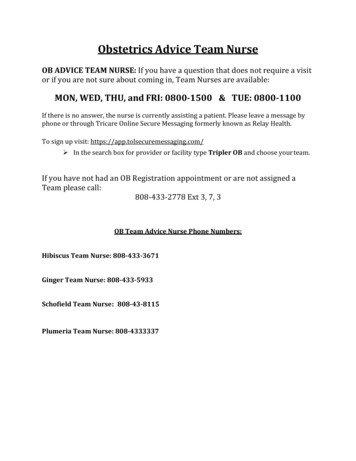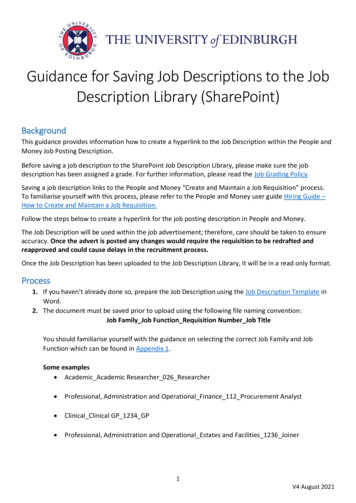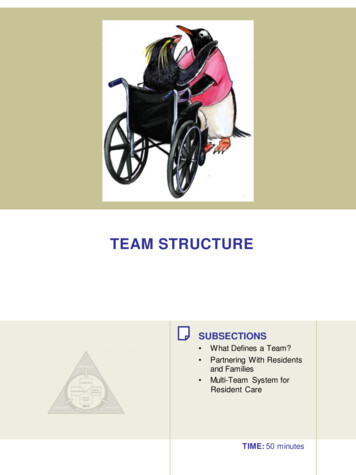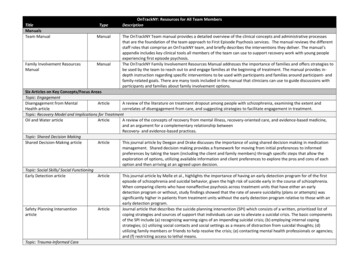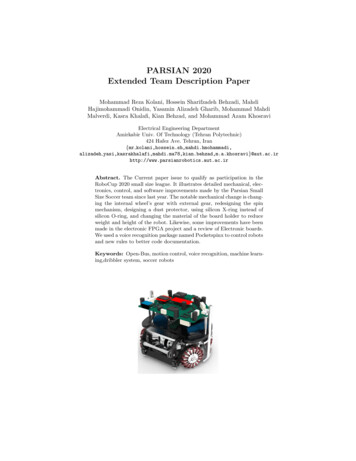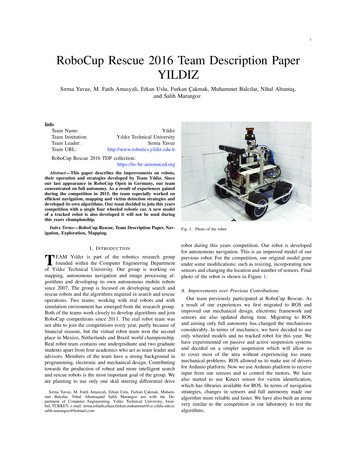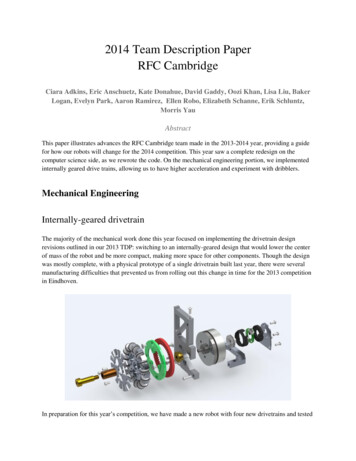
Transcription
2014 Team Description PaperRFC CambridgeCiara Adkins, Eric Anschuetz, Kate Donahue, David Gaddy, Oozi Khan, Lisa Liu, BakerLogan, Evelyn Park, Aaron Ramirez, Ellen Robo, Elizabeth Schanne, Erik Schluntz,Morris YauAbstractThis paper illustrates advances the RFC Cambridge team made in the 2013-2014 year, providing a guidefor how our robots will change for the 2014 competition. This year saw a complete redesign on thecomputer science side, as we rewrote the code. On the mechanical engineering portion, we implementedinternally geared drive trains, allowing us to have higher acceleration and experiment with dribblers.Mechanical EngineeringInternally-geared drivetrainThe majority of the mechanical work done this year focused on implementing the drivetrain designrevisions outlined in our 2013 TDP: switching to an internally-geared design that would lower the centerof mass of the robot and be more compact, making more space for other components. Though the designwas mostly complete, with a physical prototype of a single drivetrain built last year, there were severalmanufacturing difficulties that prevented us from rolling out this change in time for the 2013 competitionin Eindhoven.In preparation for this year’s competition, we have made a new robot with four new drivetrains and tested
it. After refining the design in the coming weeks, we will scale up manufacturing to build enough newdrivetrains for our entire fleet of robots. In preparation, we have been making enough parts for the newwheel design so they can be quickly assembled in April.We have also started ordering custom-made motors from Maxon directly. While this doesn’t involve largechanges to the drivetrain design, it will save us in assembly time. Previously, we had to shorten the motorshaft to accommodate the more compact internal gear design. This was labor intensive and risky, assometimes the process broke the motors. In addition, because there is no space to place the encoderassembly in front of the motor, we machined small posts to glue to the back face of the motor, on whichwe could place the encoder disk. However, making and gluing on these posts was very labor intensive,and it was difficult to ensure that the the posts were centered properly, leading to misalignment of theencoder assembly. This reduced quality of feedback, which in turn decreased the performance of ourcontrols.This year, we are ordering motors with the shafts already pushed through to the correct length. Thoughthey are still being built and shipped to us, we predict this modification will also help us in reliability ofcontrol over the wheels.DribblerThis past fall, a major focus of the mechanical subteam was designing a dribbler. We built off knowledgefrom tests last spring to create a series of new designs using materials that avoided the bubbling andshearing problems brought up in last year’s Team Description Paper. By switching from urethane rubberto a low-durometer (Shore OO-30) silicone rubber, we were able to get a much more durable roller with a
better finish for contacting the ball.In addition to changing the material, we experimented with different geometrical parameters of thedribbler, particularly the shape of the dribbler. The above casting process enables us to work with shapesthat are typically not machinable, and so we experimented with the following longitudinal shapes: flat,convex, concave, as well as a wavy shape based on a sine curve.We found that the sine curve shape centered the ball the best and allowed for the greatest control of theball while turning. Additionally, we experimented with the radius of the dribbler (i.e. how thick thethinnest portion was). We eventually settled on a medium thickness: too thin, and the dribbler was unableto retain the ball. Too thick, and the material would stretch outwards due to the centrifugal forces of thedribbler spinning, inadvertently pushing the ball away instead of catching it.The dribbler design is dependent on creating a new generation of wheel modules. This is because movingthe motors to the lower half of the robot frees up space for a wider dribbler above. Consequently, most ofour efforts have been on making a robot with a completely redesigned set of internally geared motors.Now that we have accomplished that goal, a portion of our team will make the final modifications toincorporate it into the final design.Thermoforming shieldsThis year we are switching the method we use to manufacture our shields. In the past, the processinvolved manually heating and warping plastic sheets to achieve the general cylinder shape, thenmanually cutting out the holes for exposing the wheels and other parts of the robot. The resulting shieldswere not very robust and did not do a good job of protecting the robots. In addition, shields were highlyinconsistent between individual robots, leading to alignment issues. In order to get a more uniform result,we investigated using vacuum thermoforming for creating our shields. A preliminary test with acylindrical dummy mold showed that this would be feasible and that the thermoforming process was ableto recreate the necessary level of detail for our purposes.
We are currently building a final mold out of specialized foam, which can be used several times to createa full set of new shields.New Top PlateA major issue for the team as a whole is malfunctioning motors. During the 2013 competition inEindhoven, we started out with a full fleet of robots but by the end had only enough motors for tworobots. This is a particularly bad since the motors are the costliest components of the robot. Though themajority of failure cases involve the electrical components of the robot, e.g. poor current protection, werecently noticed that several motors malfunctioned due to the ribbon cable being worn or torn enough tosever one of the leads coming of of the motor. We determined that this was caused by the way the ribboncable needs to be twisted in order to be plugged correctly into the motherboard, which led to the cablerubbing against the sharp edges of the top plate and eventually being cut.More generally speaking, the overall cable management on the robot needed improvement. In addition tobroken motors, wiring for other components such as encoders and batteries would break from gettingcaught on edges/corners of the top plate, or from the repeated bending they underwent. The convolutedcable wiring also greatly slowed down how fast we could repair the robot or replace components duringan actual match. To address this problem, this year we are working on drilling out additional holes andreconfiguring the top plate to provide freer movement of cables (less twisting) and better storage (lesssnagging while moving other parts of the robot).
Next year, our plan is to change the design of the motherboard so that the connections will be betterpositioned to completely avoid this issue. However, for the time being we are focusing on mitigating theworst parts of the twisting in order to preserve the motors.Computer ScienceOver the past year, we have changed the way our code is structured. We changed the waydifferent systems, such as strategy, path planning, robot communication, and others are linked to amessaging system. Each module sends different message types that report updated state or newcomputational results. Other modules can register as listeners for different message types and receiveevent handlers when changes occur. There are several advantages to this system. First, It is easy toexchange modules with alternative approaches for doing the same computation. Since each module islinked to others only by the messages it sends and registers for, it is simply a matter of starting onemodule instead of the other and does not require any changes in the other modules. Another advantage isthat new information can be processed as soon as it is received. Previously, new information had to make
its way through several control loops that ran at set frequencies. With the new event based messagingsystem, new data is processed as soon as an event is triggered.This year we focused on changing our codebase to a Messaging Architecture to make it morerobust, more modular, and more scalable for future development. Previously, there was no separationbetween modules, and calls were made between many different places in the codebase, making debuggingand isolating problems very difficult. To replace this, we created a central Messaging System, which eachpart of the code interfaces with, instead of interfacing directly with other classes.For instance, instead of our strategy algorithm waiting in a loop for each new piece ofinformation about the field state, it passes a handler to the Messaging System so that it can be notifiedimmediately when there is more information. The Messaging System is also designed for highconcurrency, with each category of message running on its own thread so that a bottleneck in one part ofthe code will not affect the performance of another.Having a decoupled messaging architecture also opens up the possibility for us to separatedifferent pieces of the code into different executables potentially even running on different computersover a network interface.Electrical EngineeringThis year, the electrical engineering team focused on debugging old problems that showed up in the 2013competition. Because this year saw such dramatic changes in the computer science and mechanicalengineering groups, we are planning to postpone the next generation in electrical engineering design untilnext fall, for financial reasons as well as constraints on the time of team members.
Thermoforming shields This year we are switching the method we use to manufacture our shields. In the past, the process involved manually heating and warping plastic sheets to achieve the general cylinder shape, then manually cutting out the holes for exposing the wheels and other parts of the robot. The resulting shields


